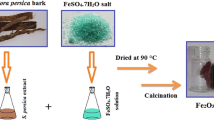Abstract
Chitosan-modified magnetic nanoparticles are a promising basis for the creation of new diagnostic agents and therapeutic drugs. The cells of erythroid, granulocytic, monocytic, lymphocytic, and megakaryocytic lineages of bone marrow of mature rats were investigated for 120 days after single injection of 0.14 g per 1 kg body weight chitosan-modified magnetic nanoparticles (Fe3O4). Light microscopy was applied to describe the structure of hematopoietic cells and morphometric study was performed on Romanowsky—Giemsa stained smears to measure cells size (µm) and relative number (%). Comparison of the biological effects of nonmodified and modified magnetite nanoparticles on hematopoietic cells of bone marrow revealed the advantages of modification. Chitosan-modified magnetite nanoparticles did not affect the structure of hematopoietic cells in the rat bone marrow, and their injection produced a reversible increase in the relative number of monocytes, stab neutrophils and segmented neutrophils, as well as polychromatic and oxyphilic normoblasts.




Similar content being viewed by others
REFERENCES
Agnihotri, S.A., Mallikarjuna, N.N., and Aminabhavi, T.M., Recent advances on chitosan-based micro- and nanoparticles in drug delivery, J. Contr. Release, 2004, vol. 100, p. 5.
Aiba, S., Studies on chitosan: lysozymic hydrolysis of partially N-acetylated chitosans, Int. J. Biol. Macromol., 1992, vol. 14, p. 225.
Bolliger, A.P., Cytologic evaluation of bone marrow in rats: indications, methods, and normal morphology, Vet. Clin. Pathol., 2004, vol. 33, p. 58.
Chen, S., Chen, S., Zeng, Y., Lin, L., Wu, C., Ke, Y., and Liu, G., Size-dependent superparamagnetic iron oxide nanoparticles dictate interleukin-1β release from mouse bone marrow derived macrophages, J. Appl. Toxicol., 2018, vol. 38, p. 978.
Couto, D., Freitas, M., Vilas-Boas, V., Dias, I., Porto, G., Arturo, Lopez-Quintela, M., Rivas, J., Freitas, P., Carvalho, F., and Fernandes, E., Interaction of polyacrylic acid coated and non-coated iron oxide nanoparticles with human neutrophils, Toxicol. Lett., 2014, vol. 225, p. 57.
Couto, D., Sousa, R., Andrade, L., Leander, M., Lopez-Quintela, M.A., Rivas, J., Freitas, P., Lima, M., Porto, G., Porto, B., Carvalho, F., and Fernandes, E., Polyacrylic acid coated and non-coated iron oxide nanoparticles are not genotoxic to human T lymphocytes, Toxicol. Lett., 2015, vol. 234, p. 67.
Easo, S.L. and Mohanan, P.V., In vitro hematological and in vivo immunotoxicity assessment of dextran stabilized iron oxide nanoparticles, Colloids Surf., B, 2015, vol. 134, p. 122.
Gaharwar, U.S. and Paulraj, R., Iron oxide nanoparticles induced oxidative damage in peripheral blood cells of rat, J. Bbiomed. Sci. Eng., 2015, vol. 8, p. 274.
Kzhyshkowska, J., Gratchev, A., and Goerdt, S., Human chitinasees and chitinase-like proteins as indicators for inflammation and cancer, Biomarker Insights, 2007, vol. 2, p. 128.
Milto, I.V. and Sukhodolo, I.V., The structure of liver, lung, kidneys, heart and spleen of rats after repeated intravenous application of nanoparticles magnetite, Vestn. Ross. Akad. Med. Nauk, 2012, vol. 67, no. 3, p. 75.
Oberdoster, G., Oberdoster, E., and Oberdoster, J., Nanotoxicology: an emerging discipline evolving from studies of ultrafine particles, Environ. Health Perspect., 2005, vol. 113, p. 823.
Paik, S.-Y.-R., Kim, J.-S., Shin, S.J., and Ko, S., Characterization, quantification, and determination of the toxicity of iron oxide nanoparticles to the bone marrow cells, Int. J. Mol. Sci., 2015, vol. 16, p. 22243.
Pleskova, S.N., Gornostaeva, E.E., Kryukov, R.N., Boryakov, A.V., and Zubkov, S.Yu., Changes in the architectonics and the morphometric characteristics of erythrocytes under the influence of magnetite nanoparticles, Cell Tissue Biol., 2018, vol. 12. p. 127.
Ruiz, A., Ali, L.M.A., Caceres-Velez, P.R., Cornudella, R., Gutierrez, M., Moreno, J.A., Pinol, R., Palacio, F., Fascineli, M.L., de Azevedo, R.B., Morales, M.P., and Millan, A., Hematotoxicity of magnetite nanoparticles coated with polyethylene glycol: in vitro and vivo study, Toxicol. Res., 2015, vol. 4, p. 1555.
Wu, W., Chen, B., Cheng, J., Wang, J., Xu, W., Liu, L., Xia, G., Wei, H., Wang, X., Yang, M., Yang, L., Zhang, Y., Xu, C., and Li, J., Biocompatibility of Fe3O4/DNR magnetic nanoparticles in the treatment of hematologic malignancies, Int. J. Nanomed., 2010, vol. 5, p. 1079.
Wu, Q.H., Jin, R.R., Feng, T., Liu, L., Yang, L., Tao, Y.H., Anderson, J.M., Ai, H., and Li, H., Iron oxide nanoparticles and induced autophagy in human monocytes, Toxicol. Lett., 2017, vol. 22, p. 57.
Funding
This study was supported by the Program of the President of the Russian Federation for Support of Young Ru-ssian Scientists (no. 075-15-2020-190), decision of the Competition Commission of the Ministry of Education and Science of the Russian Federation, protocol no. 4 of December 27, 2019.
Author information
Authors and Affiliations
Corresponding author
Ethics declarations
Conflict of interest. The authors declare that they have no conflict of interest
Statement of compliance with standards of research involving humans as subjects. The study protocol (no. 4253 dated September 28, 2015) was approved by the decision of the Local Ethics Committee of the Siberian State Medical University of the Ministry of Health of the Russian Federation (Tomsk).
Additional information
Translated by I. Fridlyanskaya
Abbreviations: NPM—magnetite nanoparticle (nanosphere), NM-NPM—chitosan nonmodified NPM, M-NPM—chitosan-modified NPM, MNP—mononuclear phagocytes.
Rights and permissions
About this article
Cite this article
Milto, I.V., Shevtsova, N.M., Ivanova, V.V. et al. Hematopoietic Bone Marrow Cells of Rat after Intravenous Administration of Chitosan-Modified Magnetite Nanoparticles. Cell Tiss. Biol. 15, 67–76 (2021). https://doi.org/10.1134/S1990519X21010090
Received:
Revised:
Accepted:
Published:
Issue Date:
DOI: https://doi.org/10.1134/S1990519X21010090



